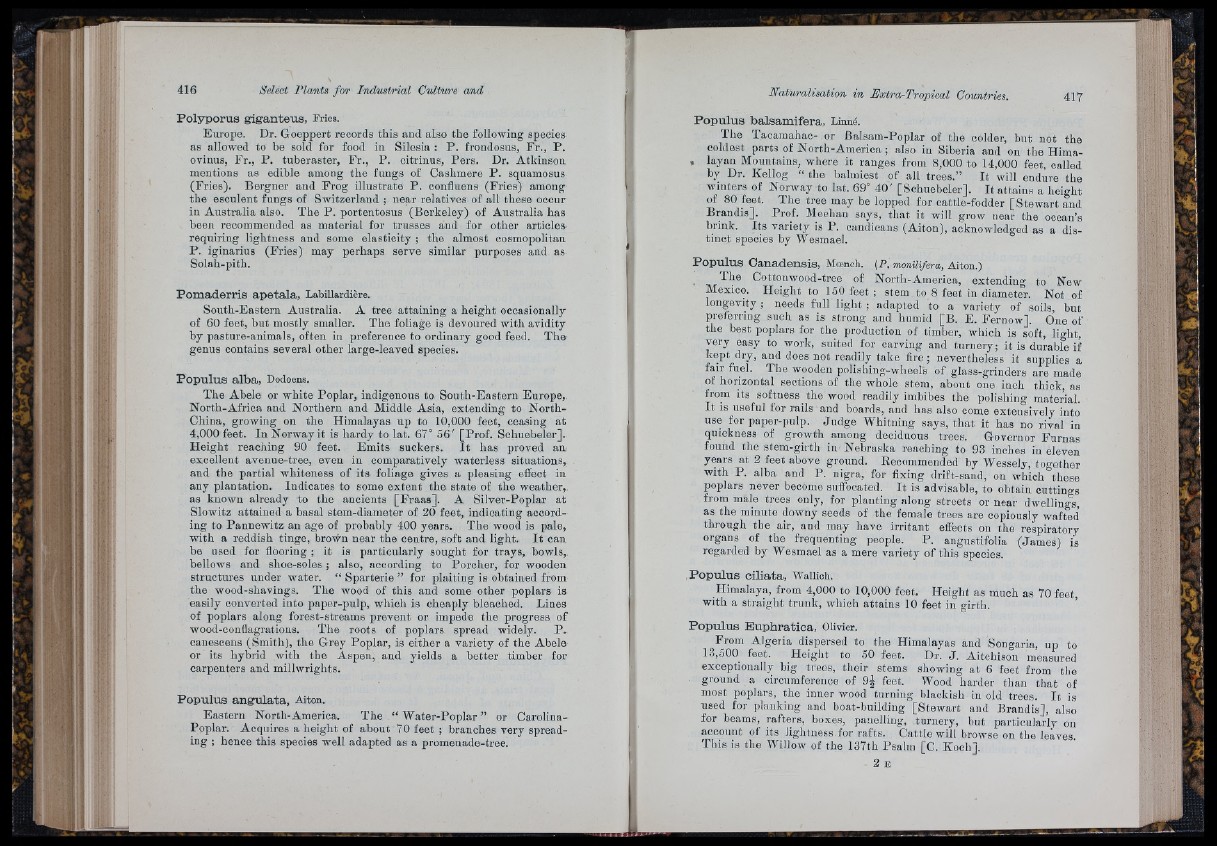
417
Polyporus giganteus, Fries.
Europe. Dr. Goeppert records this and also the following species
as allowed to be sold for food in Silesia : P . frondosas, F r., P .
ovinus, Fr., P. tuberaster, Fr., P. citrinus, Pers. Dr. Atkinson
mentions as edible among the fungs of Cashmere P. squamosus
(Fries). Bergner and Frog illustrate P. confluens (Fries) among
the esculent fungs of Switzerland ; near relatives of all these occur
in Australia also. The P. portentosus (Berkeley) of Australia has
been recommended as material for trusses and for other articles
requiring lightness and some elasticity ; the almost cosmopolitan
P . iginarius (Pries) may perhaps serve similar purposes and as
Solah-pith.
Pomaderris apétala, Labillardiére.
South-Eastern Australia. A tree attaining a height occasionally
of 60 feet, but mostly smaller. The foliage is devoured with avidity
by pasture-animals, often in preference to ordinary good feed. The
genus contains several other large-leaved species.
Populus alba, Dodoens.
The Abele or white Poplar, indigenous to South-Eastern Europe,.
North-Africa and Northern and Middle Asia, extending to North-
China, growing on the Himalayas up to 10,000 feet, ceasing at
4,000 feet. In Norway it is hardy to lat. 67° 5 6 ' [Prof. Schnebeler].
Height reaching 90 feet. Emits suckers. I t has proved an
excellent avenue-tree, even in comparatively waterless situations,
and the partial whiteness of its foliage gives a pleasing effect in
any plantation. Indicates to some extent the state of the weather,
as known already to the ancients [F ra a s]. A Silver-Poplar at
Slowitz attained a basal stem-diameter of 20 feet, indicating according
to Panuewitz an age of probably 400 years. The wood is pale,
with a reddish tinge, brown near the centre, soft and light. I t can
be used for flooring ; it is particularly sought for trays, bowls,
bellows and shoe-soles ; also, according to Porcher, for wooden
structures under water. “ Sparterie ” for plaiting is obtained from
the wood-sbavings. The wood of this and some other poplars is
easily converted into paper-pulp, which is cheaply bleaobed. Lines
of poplars along forest-streams prevent or impede the progress of
wood-oonflagrations. The roots of poplars spread widely. P.
canescens (Smith), the Grey Poplar, is either a variety of the Abele
or its hybrid with the Aspen, and yields a better timber for
carpenters and millwriglits.
Populus angulata, Aiton.
Eastern North-Amerioa. The “ Water-Poplar ” or Carolina-
Poplar. Acquires a height of about 70 feet ; branches very spreading
; hence this species well adapted as a promenade-tree.
Populus balsamifera, Linné.
The Taeaiuahac- or Balsam-Poplar of the colder, but not tho
coldest parts of North-America ; also in Siberia and ou the Hima-
, layan Mountains, where it ranges from 8,000 to 14,000 feet, called
by Dr. Kellog “ the balmiest of all trees.” I t will endure the
winters of Norway to lat. 69° 4 0 ' [Schuebeler]. I t attains a height
of 80 feet. The tree may be lopped for cattle-fodder [Stewart and
Brandis]. Prof. Meehan says, that it will grow near the ocean’s
brink. Its variety is P. candicans (Aiton), acknowledged as a distinct
species by Wesmael.
Populus Canadensis, Moench. (P. monilifera, Aiton.)
Ih e Cottonwood-tree of North-Amerioa, extending to Now
Mexico. Height to 150 feet ; stem to 8 feet in diameter. Not of
longevity ; needs full light ; adapted to a variety of soils, but
preierring such as is strong and humid [B. E. F¿rnow], One of
the best poplars for the production of timber, which is soft, light,
very easy to work, suited for carving and turnery; it is durable if
kept dry, and does not readily take fire ; nevertheless it supplies a
fair fuel. The wooden polishing-wheels of glass-grinders are made
of horizontal sections of the whole stem, about one inch thick, as
from its softness the wood readily imbibes the polishing material.
I t is useful for rails and boards, and has also come extensively into
use for paper-pulp. Judge Whitning says, th a t it has no rival in
quickness of growth among deciduous trees. Governor Furnas
found the stem-girth in Nebraska reaching to 93 inches in eleven
years at 2 feet above ground. Recommended by Wessely, together
with P. alba and P. nigra, for fixing drift-sand, on which these
poplars never become suifocated. I t is advisable, to obtain cuttings
from male trees only, for planting along streets or near dwellings,
as the minute downy seeds of the female trees are copiously wafted
through tbe air, and may have irritant effects on the respiratory
organs of the frequenting people. P. angustifolia (James) is
regarded by Wesmael as a mere variety of this species.
Populus ciliata, Wallich.
Himalaya, from 4,000 to 10,000 feet. Height as much as 70 feet,
with a straight trunk, which attains 10 feet in girth.
Populus Buphratica, Olivier.
From Algeria dispersed to the Himalayas and Songaria, up to
18,500^ feet. Height to 50 feet. Dr. J . Aitchison measured
exceptionally big trees, their stems showing at 6 feet from tlie
ground a circumference of 9L feet. Wood harder than th a t of
most poplars, the inner wood turning blackish in old trees. I t is
used for planking and boat-building [Stewart and Brandis], also
for beams, rafters, boxes, panelling, turnery, but particularly on
account of its iiglitness for rafts. Cattle will browse on the leaves
This is the Willow of the 137th Psalm [C. Koch],